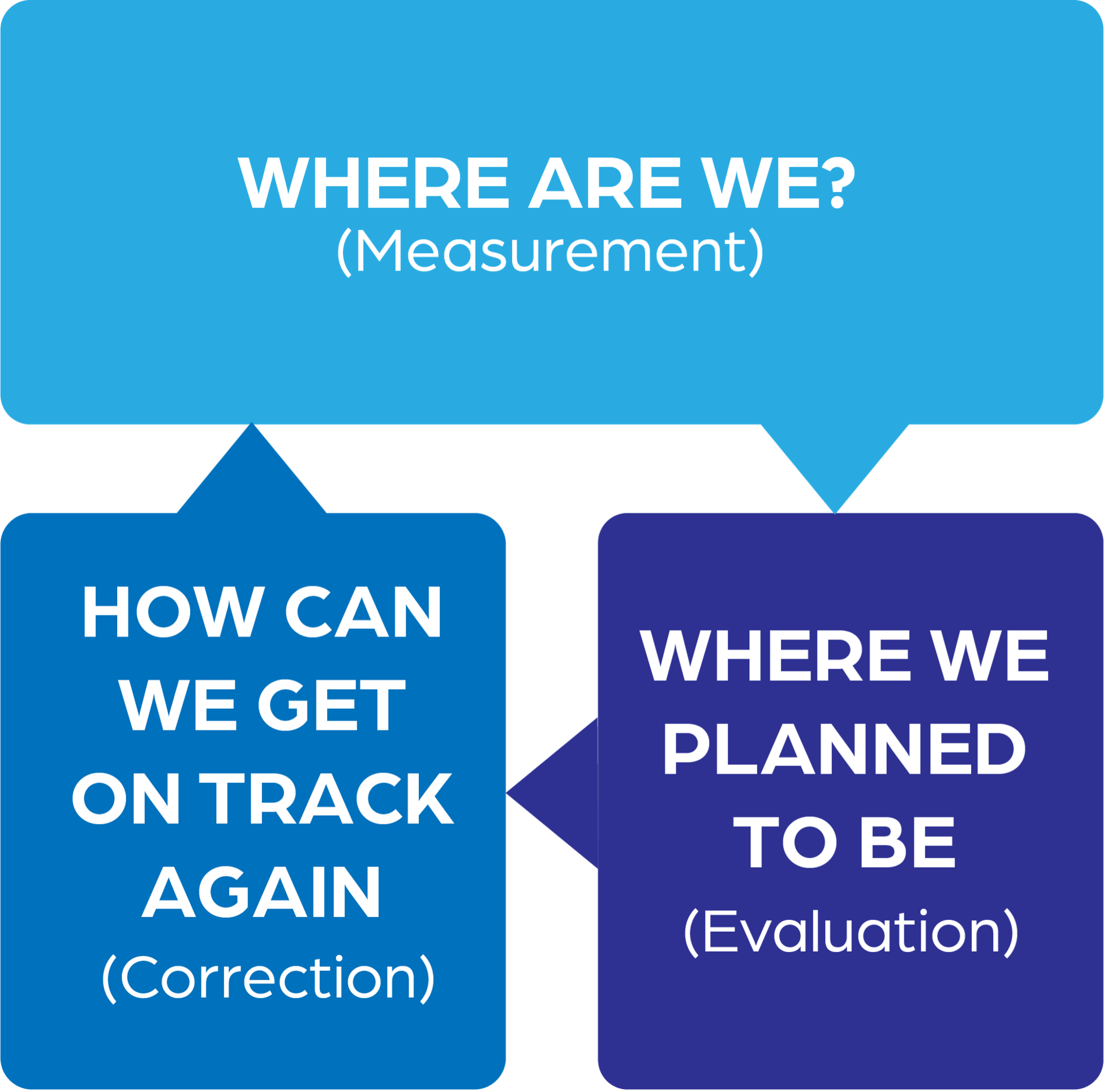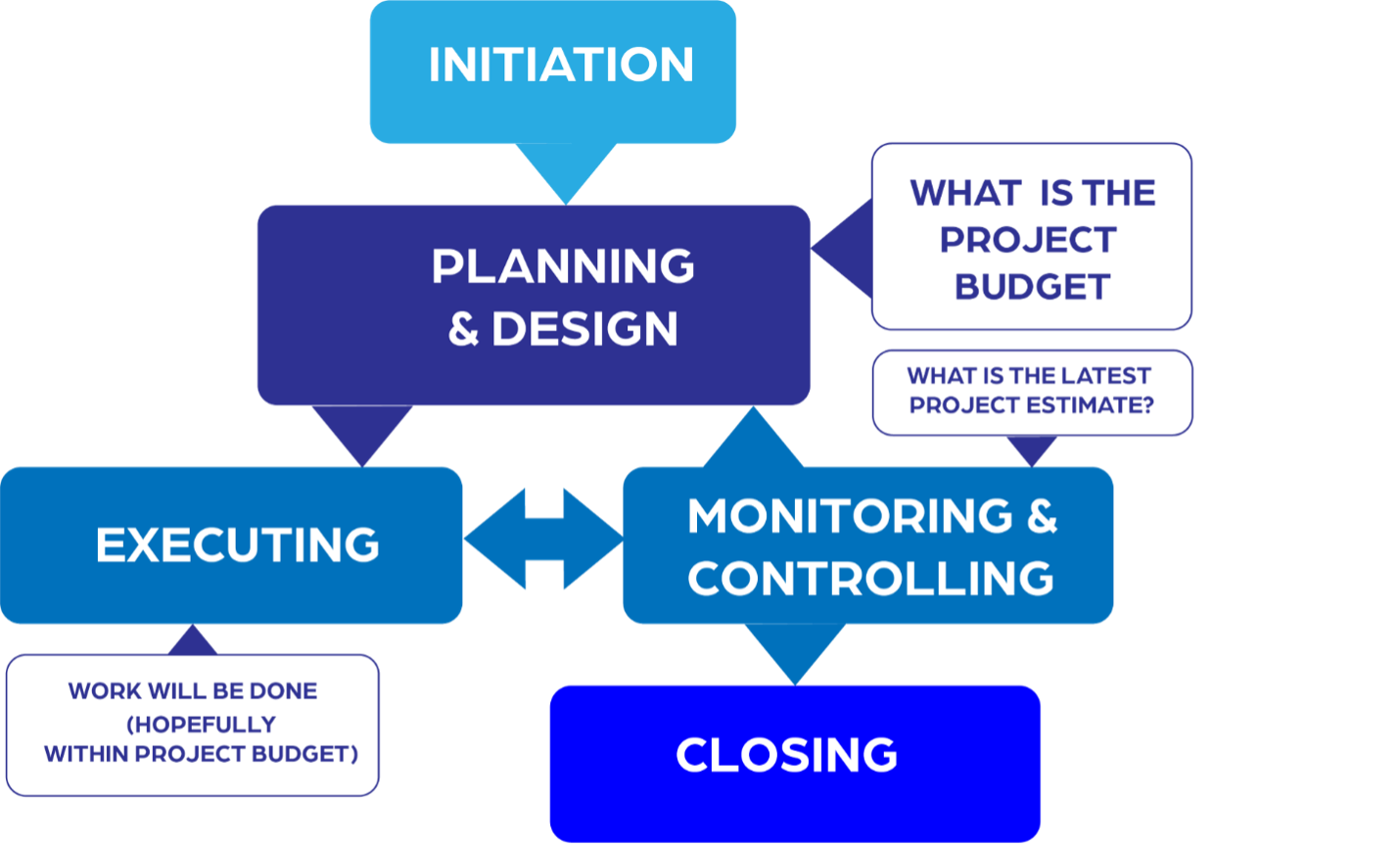Search for articles or browse our knowledge portal by topic.
Monitoring Scope, Schedule, and Budget
| Monitoring Scope Schedule and Budget | Project Classification | |||
| Capital Improvement Projects | Safety Projects | Asset Management Projects | Maintenance Projects | |
| 1. Introduction | x | x | x | x |
| 2. Monitoring the Scope | x | x | x | x |
| 3. Monitoring the Schedule | x | x | x | x |
| 4. Monitoring the Budget | x | x | x | x |
| x = Information from the topic may be applicable for the project classification. | ||||
The full definitions for terms included in this article (listed below) can be found in the HKP Glossary.
-
Scope
-
Scope Creep
-
Schedule
-
Critical Path
-
Budget
-
Estimate
-
Cost Control
-
Quality
A successful project meets the defined scope, stays on schedule and within budget, and produces quality solutions and deliverables. The project management triangle (Figure 1) illustrates the relationship between time, cost, scope, and quality. These variables are interrelated, which means adjusting one affects the others. For instance, modifying the scope influences the project cost, amount of time needed to deliver a project, and the project’s finished quality. As work progresses, the Project Manager (PM) should monitor, assess, and refine the scope, schedule, and budget as necessary. When a change to one of these items occurs, the PM needs to investigate the causes for the change, notify and discuss the changed conditions with the Project Development Team (PDT), and take corrective action to address the changed condition.

When monitoring the scope, schedule, and budget, subject-matter experts (SMEs) on the PDT provide advice and guidance, however, the PM is responsible for making timely decisions to keep the project moving forward. Major decisions that would modify the scope, schedule, and budget need to be elevated to the State Highway Engineer’s (SHE) Office for concurrence.
PMs can employ the MITAR (Monitor, Investigate, Take Action, Report) framework when overseeing projects.
MONITOR: At each milestone meeting, the PM and PDT should compare the scope defined earlier in project development to the scope detailed in project plans. Further scope refinement is expected during the project development process, but PMs should strive to ensure that project’s scope does not expand (i.e., scope creep). For more information about project milestones, refer to HKP Article Project Schedule and Development of Milestones (coming soon).
INVESTIGATE: When issues arise related to scope changes, the PM, PDT, and SHE Office need to understand the source(s) of those changes. Potential causes include unforeseen needs, stakeholder requests, unforeseen environmental concerns, changes in existing site conditions, the type of work needed to resolve an issue, scope creep, or a poorly defined initial scope.
TAKE ACTION: Once the root cause(s) of scope changes are identified, the PM and PDT brainstorm possible solutions to resolve the underlying issues. Multiple solutions should be developed, with a list of pros and cons, as well as schedule and budget impacts, noted for each. The PM, with input from the PDT, decides whether scope modifications are needed. The PM then notifies the Central Office Liaison of the potential scope change to decide next steps, including a possible request for approval to the SHE’s Office for a significant project scope modification. If budget increase is less than 15%, the modified scope meets the purpose and need of the project, and schedule isn’t affected, the CO Liaison or Director can approve the scope modification.
REPORT: Communicate changes in project scope to all PDT members once the scope modification is approved.
Red Flag
Although their funding sources may differ, strategies described in this article for monitoring the scope, schedule, and budget can be used by PMs working on any of the four types of KYTC projects: Capital Improvement, Asset Management, HSIP, and Maintenance.
Side Note
To help with the various KYTC project types, the Divisions involved have liaisons in central office that work with their assigned districts to help coordinate/facilitate various tasks involved with a project and help to get that project thru the process and completed. The liaisons for the different project types are as follows:
- Capital Improvement Projects: Location Engineers located in the Division of Highway Design, Roadway Design Branch.
- Asset Management Projects: Operations and Pavement Management Section and Bridge Maintenance/Preservation Branch.
- HSIP Projects: Highway Safety Engineer located in the Division of Traffic Operations, Traffic Safety Branch.
- Maintenance Projects: Field Engineers located in the Division of Maintenance

Figure 2: Process flowchart for managing project scope, schedule, and budget. (From Project Managers Bootcamp (PMBC) )
A good scope defines project expectations and goals and clarifies project objectives. At each milestone meeting the PM and PDT should compare the project’s initial scope to the current scope detailed in the plans.
Red Flag
The scope is refined throughout project development, but the PM and PDT should avoid scope creep — uncontrolled changes or continuous growth in the project’s scope. This can occur when the scope is not properly defined, documented, or controlled.
Scope changes should not be approached lightly as they can influence the budget and schedule. Depending on how far environmental analysis has progressed, a scope change could greatly affect the type of environmental approval needed and the timeline for obtaining it. If the scope changes during project development, the PM and PDT must investigate and understand why the scope has changed. Factors that contribute to scope changes include unforeseen conditions, stakeholder requests, and modifications in type of work to be accomplished due to issues uncovered during project development.
Once the underlying causes are understood, the PM, PDT, and the Central Office Liaison should discuss possible solutions to resolve issues related to the scope change. When developing solutions, impacts to the schedule and budget must be considered. The PM and Central Office Liaison must notify the SHE Office as soon as possible of a significant scope modification. If additional funds are needed to execute the scope change, at the request of the CO Liaison, the Division of Program Management needs to be involved in determining a funding source and when (or if) the funds could be added to the project. Additional funding may need to be programmed into the next Highway Plan. Questions about funding should be resolved before continuing the project.
For more information on scoping, refer to the PMGB Article Project Scoping and the Highway Design Guidance Manual (HD-202.6).
3. Monitoring the Schedule
A successful project cannot achieve its desired outcome until it is constructed and open to the traveling public. Thus, keeping a project on schedule and letting to construction when planned is critical. A reasonable project schedule minimizes conflicts and confusion and builds in mechanisms for accountability. The PM must (1) communicate and manage the expectations related to the project schedule and (2) track and manage the progress of the work and the use of resources to accomplish work within the project schedule. The PM should provide quarterly updates to the PDT on schedule status and progress. This helps the PDT focus on delivering the project according to the established schedule by reminding team members that the time-value of money increases project expenses if delays occur. Projects that are discussed at the Monthly Letting Review Meetings in Central Office will also require updates by the PM to the CO Liaisons prior to the meeting. Using Microsoft Project to create a Gantt chart is a very useful for helping PMs track the project schedule. It can be used to establish the initial schedule, milestones, and critical path. If a consultant is used on the project, the PM can request as a part of negotiations that they develop and maintain a Gantt chart and provide regular updates as directed.
PMs must closely monitor the critical path. Modifying the duration of activities on the critical path affects the project completion date. If Gantt Charts are not available, the PM should review project milestones and KYTC’s Project Development Process (PDP). It is also a good idea to review activities off the critical path to determine if a delay would place them on the critical path. The PM and PDT should review and discuss the project schedule at milestone meetings. If activities on the schedule start to slip, the PM and PDT should investigate the root causes. It is important to understand the causes for delays so that corrective actions can be taken to resolve the problems. Potential sources of delay include inaccurate original estimates for the schedule, unforeseen issues, and overscheduled resources. There are also delays such as organizations outside of KYTC’s control (i.e. railroads, private utilities).
PMs need to collaborate with all participating SMEs to understand issues related to their areas of expertise and identify resolutions. Possible corrective actions include acquiring additional resources, improving coordination between team members, and sometimes extending the project schedule. Before implementing a solution, the PM should discuss it with the PDT. Any major changes to the project schedule should be further discussed with Chief District Engineer, SHE Office, Central Office Liaison, and — if possible — the project sponsor.

Figure 3: Process flowchart for managing project schedules. (From PMBC)
For more information on project schedules and Gantt charts refer to the PMGB Articles Project Time Managementand Project Schedule and Development of Milestones (coming soon)
Red Flag
Sometimes it is necessary to plan a project’s tasks, letting schedule, and construction to coincide with certain months of the year. For example, on bridge replacement projects, the project corridor should be investigated to determine whether it is on a school bus route. If the corridor has a school bus route, construction should occur during summer to avoid impacts from school traffic. If endangered flora or fauna are thought to occupy a project corridor, there may be a limited window to investigate whether they are present. For example, buffalo clover has a short blooming season and each spring only a small window of opportunity is available to determine if it is present. In situations like these, the project development schedule and delivery to the letting on time is highly critical. Instead of missing a letting by one month, the project letting could be moved to the next year.
4. Monitoring the Budget

From the PMBC Project Cost Management presentation.
The Enacted Highway Plan contains authorized project budgets. When developing alternatives that address the project purpose and need, the PM needs to draw on information in the plan, including the project description, funding cost estimates, and fiscal years indicated for each project phase. The PM should also consider supporting information that was used to program the project into the highway plan, including planning studies, scoping studies, and Project Identification Forms (PIF).
Throughout project development, the PM must track and update project estimates for design (D), right of way (R), utilities (U), and construction (C) phases in the PDP Precon system. Estimates should be updated at the following points:
- Issuance of a new Highway Plan (every two years).
- Potential Scope Change.
- Project Milestones.
- Final Plans Submittal (Final Plans Estimate).
Estimates should be kept current to ensure programmed funds are accurate and available when requested. If estimated costs for each phase exceed Highway Plan budgets by 15 percent or more, the PM and PDT should investigate the reasons for the cost overruns and provide justification. Some explanations include prices and quantities being underestimated in previous estimates, the emergence of unforeseen issues, or scope creep.

Figure 4: Process flowchart for managing project costs. (From PMBC)
Red Flag
Red Flag
When project costs increase, the amount of funding available for other projects declines. This also negatively impacts the schedules of these projects. The PM and PDT must control project costs, ensure that only appropriate project changes are permitted, proactively inform, and discuss issues with the CO Liaison and the SHE Office, and request authorization for changes that will affect costs.
Red Flag
The PM will encounter instances of the Highway Plan’s programmed estimates not matching the type of work spelled out in the project description. When this happens, the PDT should develop an alternative that does not exceed allocated funding to demonstrate what can be accomplished with the approved budget, along with alternatives that meet the purpose and need. Solutions should be presented to the SHE Office for discussion and to establish a path forward for the project. Because limited funding cannot pay for all projects that are needed in the state, the PM, PDT, and SHE Office must evaluate solutions and choose one that best addresses the purpose and need.
For more information concerning the project budget refer to PMGB Articles Understanding the KYTC Budget and the Highway Plan and Project Cost Estimating. To learn more about tracking project funding balances refer to the KYTC PDP Precon and KYTC Project Managers Toolbox.
5. Associated Articles
PMGB Article Project Scoping (coming soon)
PMGB Article Project Schedule and Development of Milestones (coming soon).
PMGB Articles Understanding the KYTC Budget and the Highway Plan (coming soon)
PMGB Project Cost Estimating (coming soon)
PMGB Project Time Management
KYTC Design Manual HD-202.6
6. Reference Documentation
Key Section Definitions:
Budget – Funds authorized to execute the project. It establishes the cost baseline used for program management.
Estimate – Approximation of monetary resources necessary to complete project. Developed at various stages of the project to measure and track the cost.
Cost Control – Controlling changes to the project budget.
Project Management Guidebook Knowledge Book:
Access the complete Knowledge Book here: Project Management Guidebook
Next Article: Public Involvement with Customers and Stakeholders
Previous Article: Managing Project Risk

